Last Updated on: September 6, 2024
Bird watching has picked up steam in Texas. Frankly, I’d be surprised if that wasn’t the case.
Texas accommodates 640 bird species yearly, including numerous birding hotspots like smith point. Undoubtedly, Texas is a prosperous birding state for seasoned birders.
But…
Have you ever wondered about the species of hawks in Texas? I mean, it’s usual for birders to be curious about different bird species.
So, today, I’ll be your tour guide into the nebulous world of Texas hawks. You’ll discover the hawks that reside there and how you can identify these raptors while birding.
The Different Types Of Texas Hawk Species
Since 67% of the bird species interact with the Texas coast yearly, the hawks on this list aren’t the only residents of the state. But I decided to exclude the vagrant hawk species in Texas.
Below is an enlightening list of the common hawk species in Texas.
1. Red-Tailed Hawk
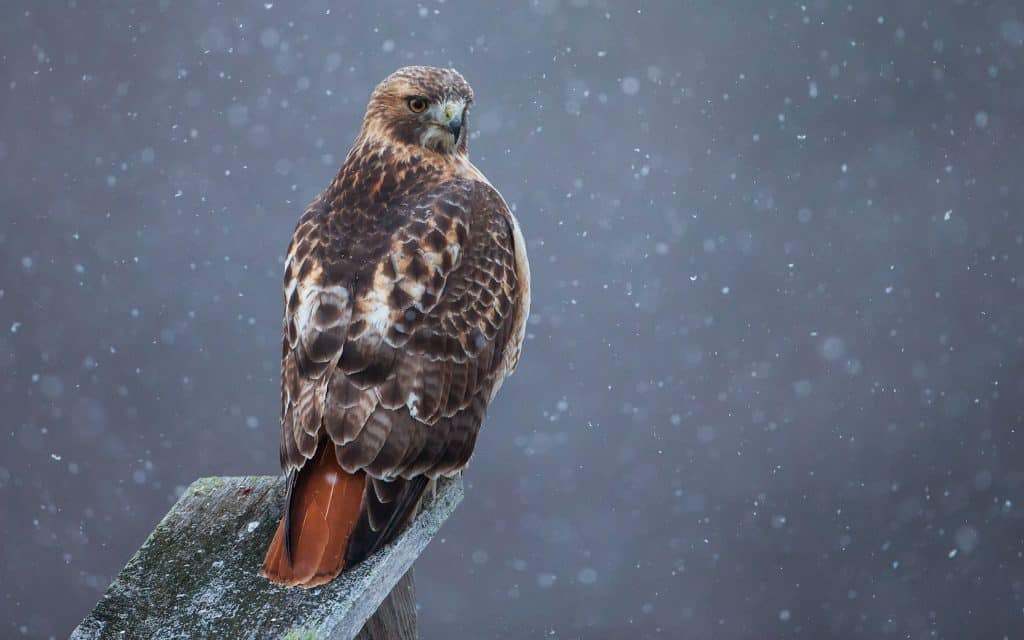
Of course, the Red Tailed Hawk is the first on my list. This bird of prey is a native of North America and Texas. So my best guess is you are probably familiar with this species.
One of the distinguishing features of this raptor is its size. It’s one of the giant hawks you’d find around. Besides the size, you can Id a Red Tailed Hawk with its signature shrill screams and overt red tail. They perch on fence posts, treetops, and telephone wires, keenly awaiting their prey.
You can also spot this bird during long drives along the dusty countryside.
Red Tailed Hawks are adaptable. They thrive in suburban areas, woodland, scrublands, or almost anywhere. They prefer high trees for nesting. Their nests often sit high up in trees with a bird’s eye view of their surroundings. They can also make use of billboard tops as their nesting place!
Unlike other hawk species, these raptors don’t frequent bird feeders. Instead, they feed on smaller mammals like mice, squirrels, rats, and birds like Starlings.
2. Cooper’s Hawk
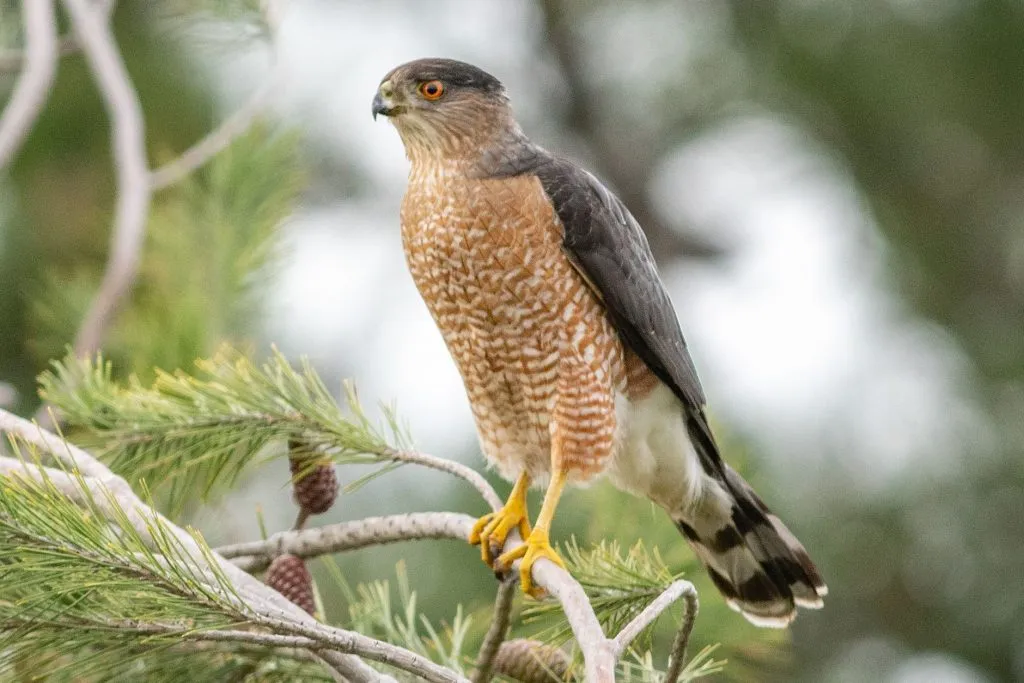
Cooper’s Hawk is a predator found in most parts of Texas. But you are more likely to stumble on one in the woods or edge of fields. Its bluish-gray head and rufous-colored back have a striking resemblance with that of a Sharp Shinned Hawk.
However, Cooper’s Hawk is medium-sized and slightly larger than a Sharp Shinned Hawk. But this difference isn’t visible during flight. Hence, you’d probably need tons of luck trying to differentiate it from a Sharp Shinned in the air.
Speaking of flight, this bird of prey has fascinating speed and agility.
Cooper’s Hawk stalks bird feeders across backyards where it feasts on small birds like Mourning Dove, European Starling, and Red Winged Blackbird visiting your feeder.
If you notice one hovering over your feeder, take down the bird feeder for a while until it finds an alternative feeding station.
3. Harris Hawk
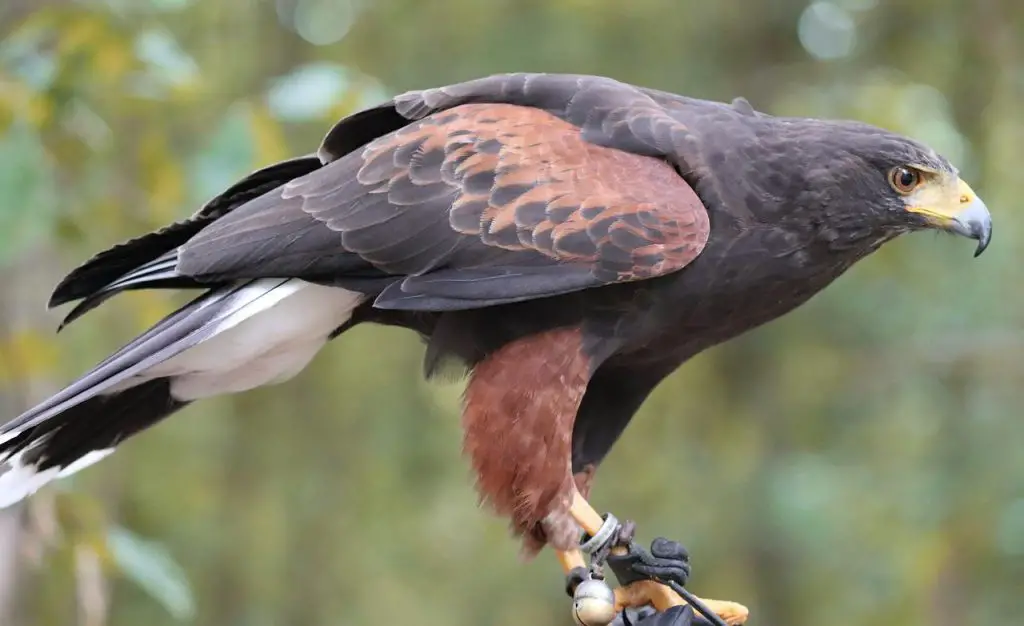
This Texas hawk is common in the southern part of San Antonio. It’s pretty with red wings, dark brown plumages, and a white tail. You’d find this bird across North America hunting in groups, sometimes up to 7.
Harris Hawk is a highly social raptor.
I find the complex social hierarchy fascinating. These birds hunt in groups with sophisticated strategies. And once they capture prey, they feed according to their dominance level. Individual Harris birds eat lizards, rodents, squirrels, and small birds.
You will find this bird in deserts on perches, boulders, and trees. Due to the peculiar habitat preference, it’s necessary to have a water source close. It’s also non-migratory; hence, they choose a habitat and stick with it.
4. Red Shouldered Hawk
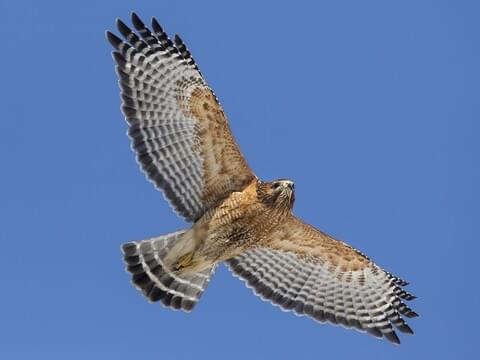
For identification, simply look out for the red shoulders. Besides the famous red shoulders, Red Shouldered Hawk has a barred, rufous chest and white underpart. It’s usual to hear a Red Shouldered Hawk before it comes into view. It repeats a call that sounds like “kee-ah.”
This raptor’s favorite habitat is a forest, and it nests in woods with an open upper canopy, where it can hunt its prey. This bird perches around suburban areas enclosed in woodlands.
Red Shouldered Hawk is a common bird whose range covers Eastern and South Texas. It devours small mammals and can also eat amphibians. One characteristic I find remarkable is its hunting style.
It drops on its prey from overhead. As a result, the target hardly sees it coming!
5. Sharp Shinned Hawk
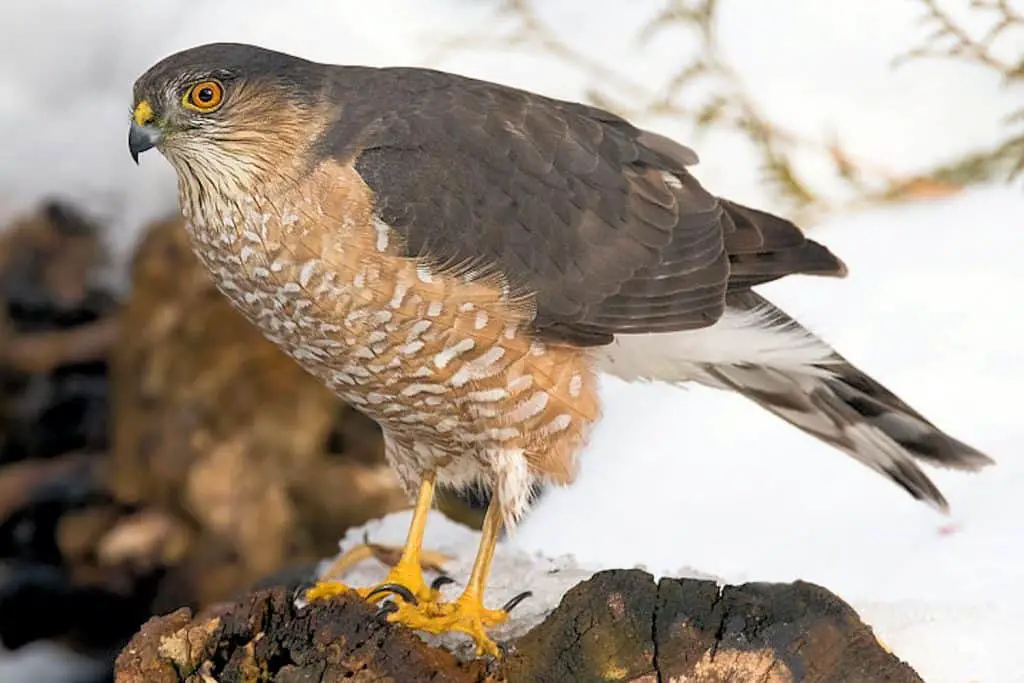
This raptor has got to be one of the most acrobatic types of hawks in Texas. It’s small and can bolt through your backyard in a split second.
Sharp Shinned Hawks share many similarities with Cooper’s Hawks, but Coopers Hawks are larger. Considering the differing size of males and females, you may struggle to differentiate a female Sharp Shinned Hawk from Coopers.
However, the barred chest displaying orange hues, which fades into a pale shade around the belly, is peculiar to them. Sharp Shinned Hawk also sports a bluish-gray wing and back. In addition, their short and rounded wings are conspicuous in flight.
This ambush predator thrives in forested areas of Texas. They stalk bird feeders hoping to ensnare songbirds like the Mourning Dove.
Sound is an effective way to differentiate between a Sharp Shinned Hawk and a Cooper’s Hawk.
The former sounds like “kik kik kik” while the latter makes a “Kak kak kak” sound. It’s a hassle to differentiate them, but not an impossible feat!
6. Swainson’s Hawk
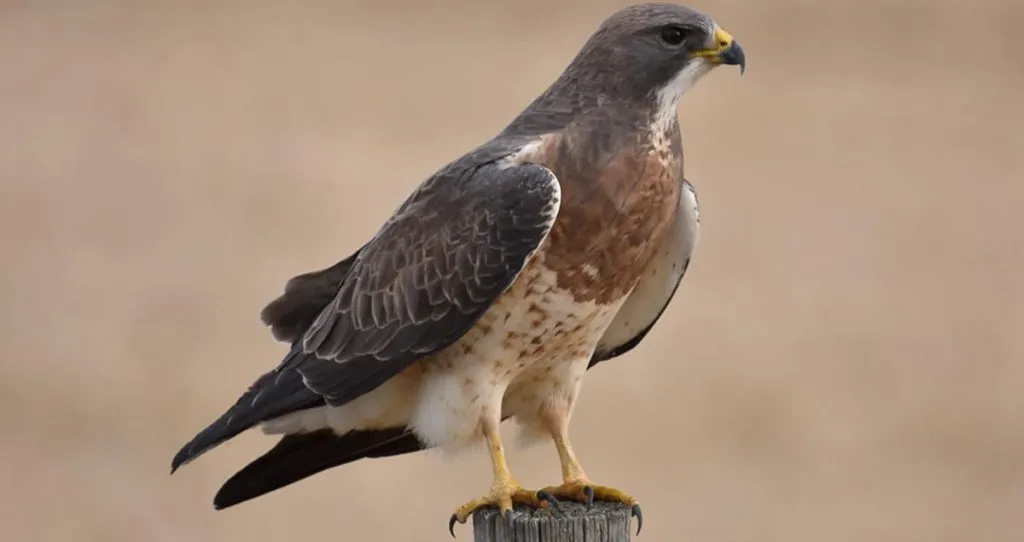
Swainson’s Hawks are migratory. They can be found in South Texas. However, their range extends to Central and North America. After breeding in Texas throughout summer, they travel as far as Argentina!
How do you recognize this hawk species? It has a white throat just after the beak. It also boasts dark brown plumages with an off-white belly and beautiful reddish-brown breast.
They often perch on dead trees and telephone wires, scanning the ground for food. If you luckily spot large flocks of Swainson’s Hawk on the field in the migratory season, mostly April or September, it’s a fantastic sight.
This medium / large-sized hawk is an opportunistic eater.
Naturally, its location and region dictate its diet. It thrives on insects and feeds on small mammals, amphibians, and reptiles.
7. Northern Harrier

A typical Northern Harrier’s love for agricultural areas and open fields makes it a frequent sighting in rural areas. You are likely to stumble on the Northern Harrier during the winter season. Their numbers thin out until April when the last of them head north.
This Harrier species are indigenous to North America. Hence, it has an affinity for grasslands where it’s easy to hear animals scrambling through the grass.
It relies on its hearing ability to hunt.
You’d always sight a Northern Harrier hovering low above grasslands, hoping to capture a rodent. This predator can also capture large prey by drowning them.
8. Broad Winged Hawk
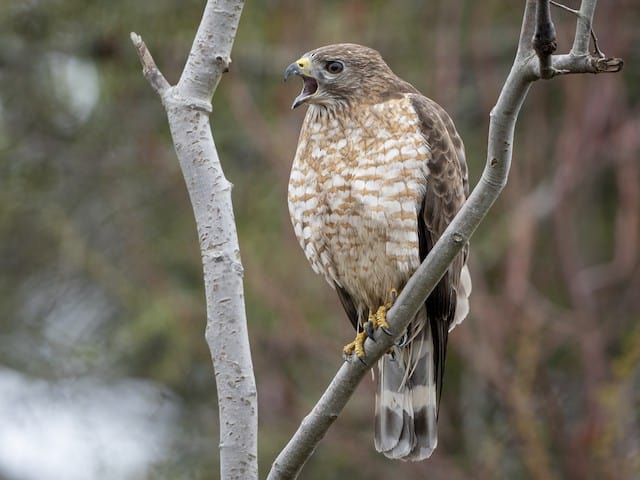
Eager to see a Broad Winged Hawk? You’d probably need to visit a forest or wander deep into the woodland. This raptor’s stocky and short appearance blends into the forest habitat, making adaptation effortless.
The Broad Winged Hawk migrates to Central and South America in winter. However, it spends summers in the United States and Canada.
It also uses the perch and pounce hunting styles. They perch on a slightly high tree and scan their surroundings. Once they sight prey, they pounce and feast. Some of their victims include frogs or toads.
This hawk has no visible markings for identification but it’s splotchy, heavily barred, and spotted.
It’s similar to Red Shouldered Hawks but is less colorful around the breast region.
9. White Tailed Hawk
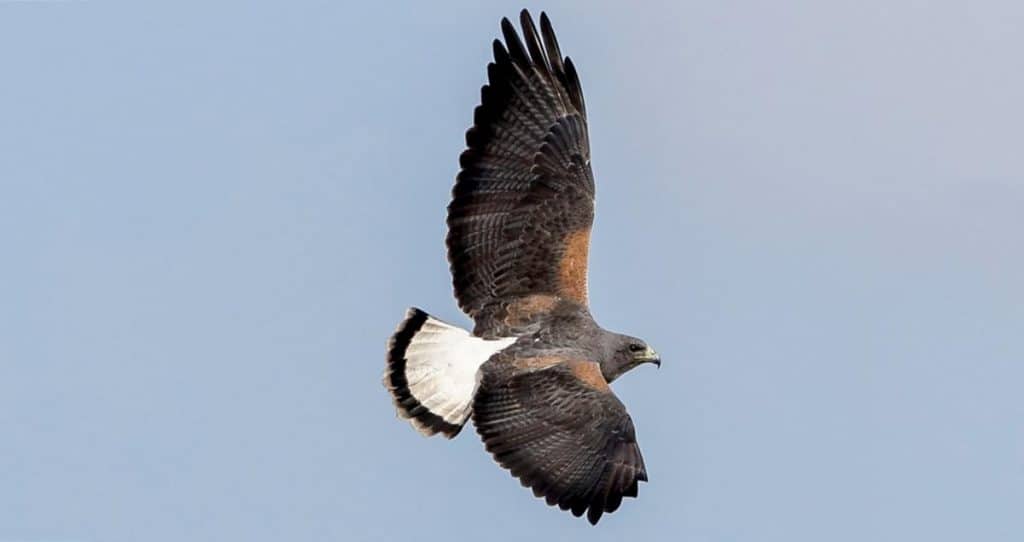
I took an instant liking to the White Tailed Hawk. For one, I am big on appearance, and I believe this raptor’s slate gray back and white tail are showy. Besides, the brilliant white tail with black bands is a dead giveaway that helps ID White Tailed hawk for a distance.
It’s predominantly found in South Texas but it generally has a penchant for grasslands, prairies, and pastures.
This bird hunts in flight, but it also drops abruptly on its prey, often on small mammals. Their high-pitched whine heralds this bird’s appearance. The whine lasts a few notes before it’s followed swiftly with repeated “ke” sounds.
The White Tailed Hawk is a rare sighting in North America. But Texas is one of the few states that accommodates this bird. It’s a more common sighting in Central and Southern America, instead.
10. Rough Legged Hawk
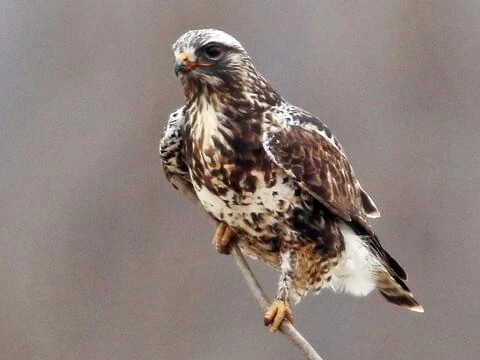
This large hawk species flaunts its enormous size in flight. But, once it lands, it smoothly compacts its large body. They breed on the Arctic Tundra and migrate south and to several regions of Texas during winter.
Rough Legged Hawk and Ferruginous Hawks have one thing in common: they have a fully feathered leg up to the toes. This feature is rare in America.
The Rough Legged Hawk lingers overhead to hunt for food. If you are looking forward to a birding adventure with this hawk in view, an open grass or desert is their preferred habitat.
Rough Legged Hawk has a diet that’s dependent on its current environment. It eats lemmings during summer and pounces on small rodents mammals in winter.
11. Northern Goshawk
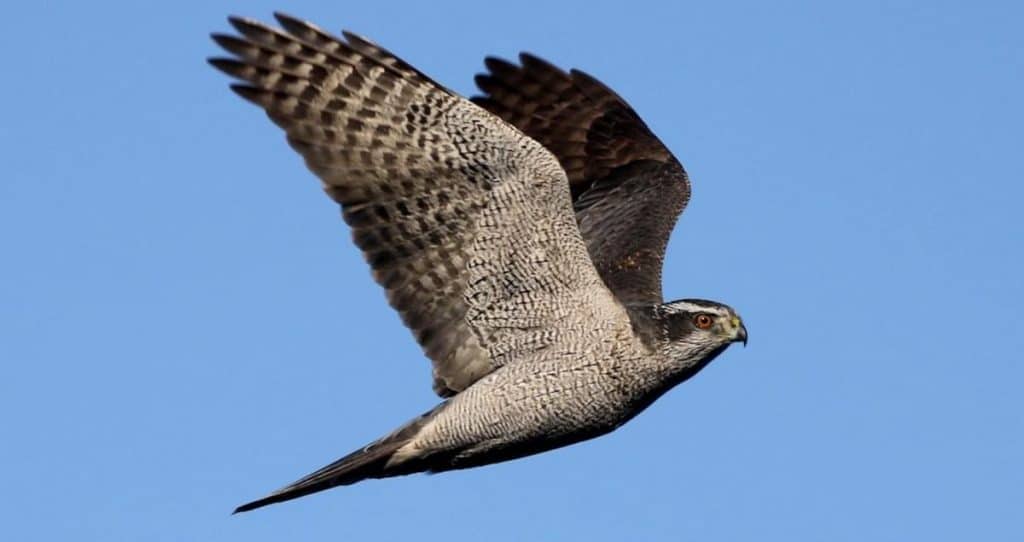
The Northern Goshawk has a limited nonbreeding range in North Texas. This large bird of prey shies away from civilization and inhabits deep parts of the forest.
Northern Goshawk has a livid colored upper body, while some morphs have brown. It equally spots a blue-white underside with stripes. But its defining appearance is the dark head color with accompanying red eyes– not your regular Texas hawk appearance.
So, if you ever spot a bird that looks like this raptor in your backyard, chances are it’s just a Cooper’s Hawk. Despite the similarity, they are different behaviorally.
This raptor is tenacious while defending its nest and doesn’t spare anything or anyone that treads too close.
Northern Goshawk eats insects, birds, reptiles, and mammals.
12. Ferruginous Hawk
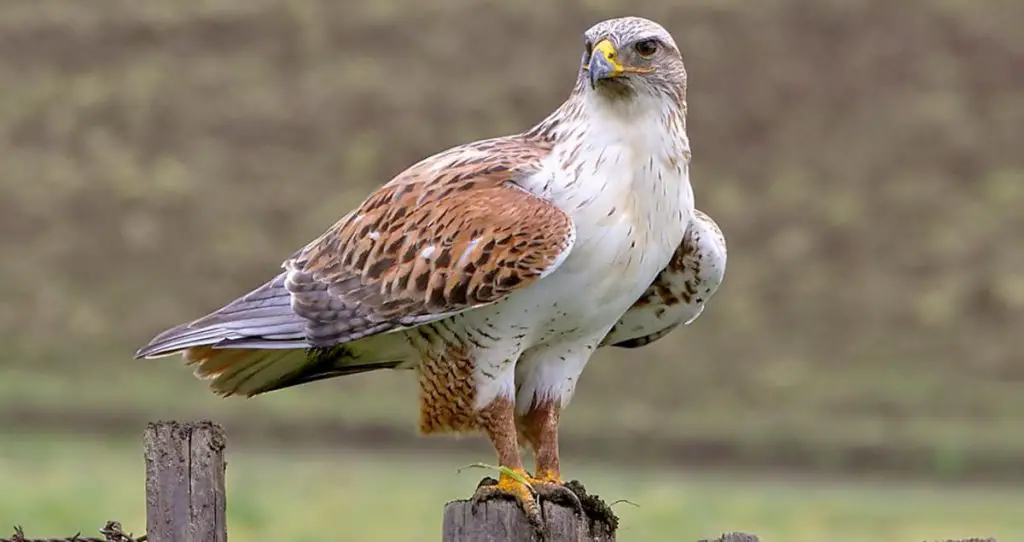
Ferruginous Hawks are one of the largest birds in North America. Like most hawks, it has two color morphs. The light morph is a russet brown with paler undersides.
While the dark morph flaunts chestnut color and dark brown plumage and bell, they are rarer than the light ones.
It roosts in large groups during winter.
The Ferruginous Hawk is social. They are not fussy with their nest. Therefore, it can nest in human-made structures. Its hunting technique includes hopping after its prey. This predator, however, has a limited diet and is predominantly of small mammals.
13. Zone Tailed Hawk
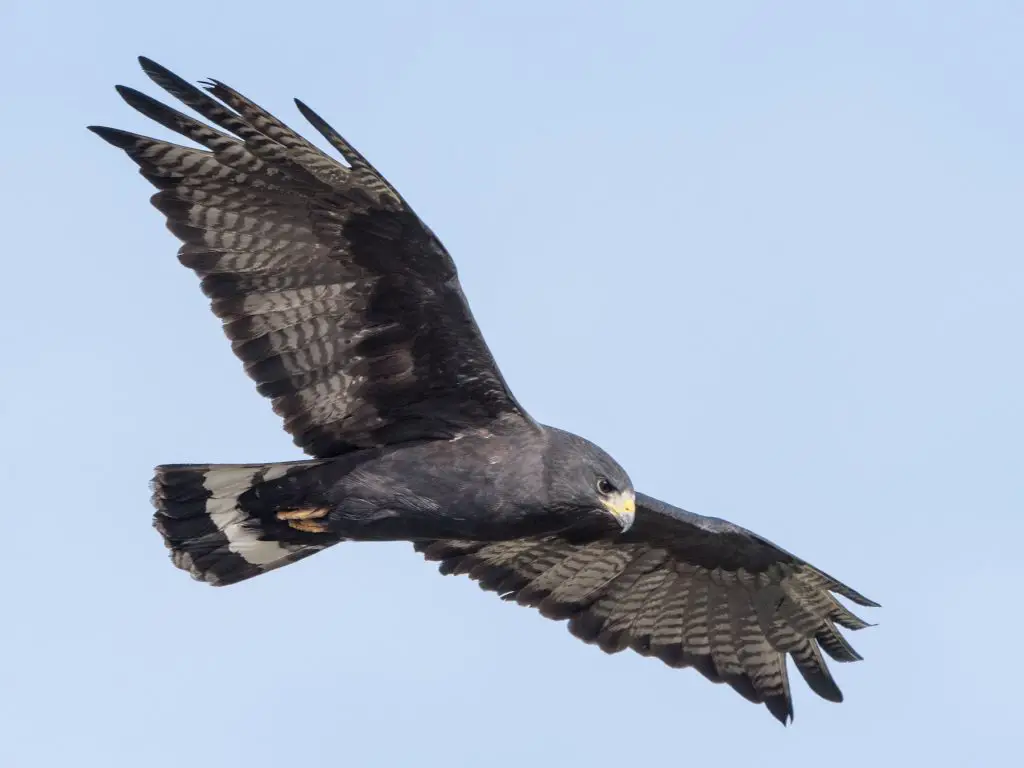
If you don’t know better, you may mistake this hawk for a Turkey Vulture. Even the flight is similar as they fly with their wings slightly raised. Well, this similarity seems to be to its advantage.
Zone Tailed Hawks fits into Turkey Vulture groups and sneak up on unsuspecting victims, making most of its mimicry.
They often migrate from Central America and Southern Mexico to North America, breeding in Eastern Texas.
Zone Tailed Hawks have a beautiful black color and an attractive white band on their tails.
14. Common Black Hawk
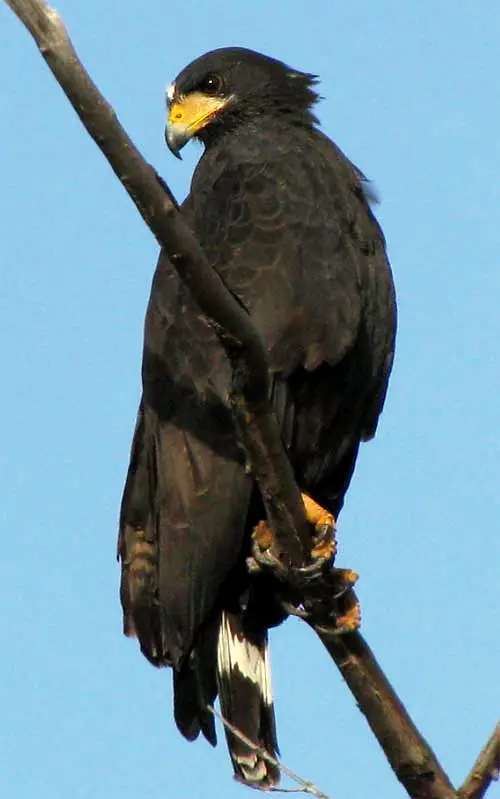
This hawk’s name betrays its appearance. As you may have guessed, it’s coral black. The only colors that contrast the complete black are the orange-yellow legs and bill, white bands on the tail, and the white patch around the bill.
The Common Black Hawk isn’t as common as you’d expect. Its range is limited to a few states in the North, including Texas.
Common Black Hawk feeds on crabs, insects, snakes, and young birds. You will catch it wading through shallow water to grab fishes, crayfish, or any other prey that appeals to it.
Watch This!
Frequently Asked Questions
Can I shoot a hawk in Texas if it tries to attack humans or animals?
The Migratory Bird Treaty Act protects most birds native to America. Hence, it’s unlawful to attack birds like hawks and eagles. You risk a jail term and a heavy fine if you harm any hawks.
These predatory animals are a natural threat both to humans and livestock.
In such a scenario, you need a Federal Migratory Bird Depredation Permit. This permit allows you to shoot hawks with a promise to employ nonlethal ways to prevent harm soon. You must have also experienced depredation or a loss because of these birds to acquire the permit.
What do Texas hawks eat?
The species determines a hawk’s diet. Hence, hawks’ diet isn’t fixed. But considering recurrent diet patterns in diverse species, they eat small mammals, reptiles, rodents, amphibians, and insects.
Some hawk species like Cooper’s Hawk’s primary diet consists of small bird-like Jays and Robins.
How often do you see hawks in neighborhoods in Texas?
You can spot hawks in different regions of Texas. While some inhabit forests and shy away from humans, other species make homes in neighborhoods around the state.
Hawks like Harris’ Hawk and Cooper’s Hawk lurk around neighborhoods where they hunt for food.
Visit the Hawk Migration Association Of North America for more detailed information about hawk migration in Texas.
How big are hawks in Texas?
Different hawk species in Texas cut across different sizes. Their sizes range from pigeons to geese. The Ferruginous Hawk is the most prominent in Northern America, with a wingspan between 53 and 56 inches wide and a height between 20 and 25 inches in length.
Conclusion
I can’t think of a better terrestrial birding location other than the second largest state in the United States. Texas offers diverse habitats for variants of hawk species.
When you see different hawk species in Texas, it’s sometimes impossible to tell them apart. Only having a deep knowledge of their nature, characteristics, and behavior truly helps identify them and make your birding adventure more thrilling!

